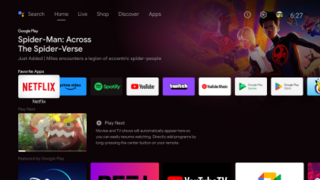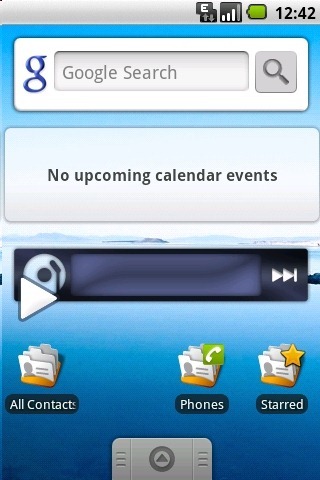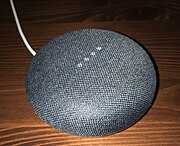
Google Nest is a line of smart home products including smart speakers, smart displays, streaming devices, thermostats, smoke detectors, routers and security systems including smart doorbells, cameras and smart locks.

Nexus Q is a digital media player developed by Google. Unveiled at the Google I/O developers' conference on June 27, 2012, the device was expected to be released to the public in the United States shortly thereafter for US$300. The Nexus Q was designed to leverage Google's online media offerings, such as Google Play Music, Google Play Movies & TV, and YouTube, to provide a "shared" experience. Users could stream content from the supported services to a connected television, or speakers connected to an integrated amplifier, using their Android device and the services' respective apps as a remote control for queueing content and controlling playback.

Chromecast is a line of digital media players developed by Google. The devices, designed as small dongles, can play Internet-streamed audio-visual content on a high-definition television or home audio system. The user can control playback with a mobile device or personal computer through mobile and web apps that can use the Google Cast protocol, or by issuing commands via Google Assistant; later models introduced an interactive user interface and remote control. Content can be mirrored to video models from the Google Chrome web browser on a personal computer or from the screen of some Android devices.
Google Cast is a proprietary protocol developed by Google for playing Internet-streamed audiovisual content on a compatible consumer device. The protocol is used to initiate and control playback of content on digital media players, high-definition televisions, and home audio systems using a mobile device, personal computer, or smart speaker. The protocol was first launched on July 24, 2013, to support Google's first-generation Chromecast player. The Google Cast SDK was released on February 3, 2014, allowing third parties to modify their software to support the protocol. According to Google, over 20,000 Google Cast-ready apps were available as of May 2015. Support for Google Cast has since been integrated into subsequent devices, such as the Nexus Player and other Android TV devices, as well as soundbars, speakers, and later models of the Chromecast. Consumer devices that natively support the protocol are marketed as Chromecast built-in. As of October 2017, over 55 million Chromecasts and Chromecast built-in devices have been sold.
The Samsung Galaxy Express 2 (SM-G3815) is a smartphone made by Samsung which was launched in October 2013 featuring a similar design and specifications of the Samsung Galaxy S4 Mini but with a bigger 4.5 inch screen and different cameras.

Amazon Fire TV is a line of digital media players and microconsoles developed by Amazon. The devices are small network appliances that deliver digital audio and video content streamed via the Internet to a connected high-definition television. They also allow users to access local content and to play video games with the included remote control or another game controller, or by using a mobile app remote control on another device.

Android TV is a smart TV operating system based on Android and developed by Google. It is available on television sets, soundbars, set-top boxes and digital media players. A successor to Google TV, it features a user interface designed around content discovery and voice search, content aggregation from various media apps and services, and integration with other recent Google technologies such as Assistant, Cast, and Knowledge Graph.

HomeKit, also known as Apple Home, is a software framework and communication protocol developed by Apple Inc. that lets users configure, communicate with and control smart-home appliances using Apple devices. It provides users with a way to automatically discover such devices and configure them. By designing rooms, items and actions in HomeKit, users can enable automations in the home through a voice command to Siri or through the Home app. With HomeKit, developers are able to create complex applications in order to manage accessories at a high level.
The Nexus Player was a digital media player co-developed by Google, Intel and Asus. It was the second media player in the Google Nexus family of consumer devices. Originally running the Android 5.0 ("Lollipop") operating system, it was the first device to employ the Android TV platform. The Nexus player supports Google Cast, the feature for selecting and controlling media playback on a television that was first introduced by Chromecast. Sales of the Nexus Player were discontinued in May 2016, and product support ended in March 2018.
Amazon Echo, often shortened to Echo, is an American brand of smart speakers developed by Amazon. Echo devices connect to the voice-controlled intelligent personal assistant service Alexa, which will respond when a user says "Alexa". Users may change this wake word to "Amazon", "Echo", "Computer", and other options. The features of the device include voice interaction, music playback, making to-do lists, setting alarms, streaming podcasts, and playing audiobooks, in addition to providing weather, traffic and other real-time information. It can also control several smart devices, acting as a home automation hub.
Android Things is a deprecated Android-based embedded operating system platform by Google, announced at Google I/O 2015, and launched in 2018. Android Things Dashboard shutdown began on January 5, 2021. After January 5, 2022, Android Things Dashboard has been shut down completely and all remaining data has been deleted.

Android Cupcake is the third version of the Android operating system, developed by Google, being the successor to Android 1.1. It was released on April 27, 2009 and succeeded by Android Donut on September 15, 2009.

The Google Assistant is a virtual assistant software application developed by Google that is primarily available on mobile and home automation devices. Based on artificial intelligence, The Google Assistant can engage in two-way conversations, unlike the company's previous virtual assistant, Google Now.
Amazon Alexa or Alexa is a virtual assistant technology largely based on a Polish speech synthesizer named Ivona, bought by Amazon in 2013. It was first used in the Amazon Echo smart speaker and the Echo Dot, Echo Studio and Amazon Tap speakers developed by Amazon Lab126. It is capable of natural language processing (NLP) for tasks such as voice interaction, music playback, creating to-do lists, setting alarms, streaming podcasts, playing audiobooks, providing weather, traffic, sports, other real-time information and news. Alexa can also control several smart devices as a home automation system. Alexa capabilities may be extended by installing "skills" such as weather programs and audio features. It performs these tasks using automatic speech recognition, NLP, and other forms of weak AI.
A smart speaker is a type of loudspeaker and voice command device with an integrated virtual assistant that offers interactive actions and hands-free activation with the help of one "hot word". Some smart speakers can also act as a smart device that utilizes Wi-Fi and other protocol standards to extend usage beyond audio playback, such as to control home automation devices. This can include, but is not limited to, features such as compatibility across a number of services and platforms, peer-to-peer connection through mesh networking, virtual assistants, and others. Each can have its own designated interface and features in-house, usually launched or controlled via application or home automation software. Some smart speakers also include a screen to show the user a visual response.
The Pixel and Pixel XL are a pair of Android smartphones designed, developed, and marketed by Google as part of the Google Pixel product line, succeeding the Nexus line of smartphones. They were officially announced on October 4, 2016 at the Made by Google event and released in the United States on October 20. On October 4, 2017, they were succeeded by the Pixel 2 and Pixel 2 XL.

Nest Wifi, its predecessor the Google Wifi, and the Nest Wifi's successor, the Nest Wifi Pro, are a line of mesh-capable wireless routers and add-on points developed by Google as part of the Google Nest family of products. The first generation was announced on October 4, 2016, and released in the United States on December 5, 2016. The second generation, distinct in being released as two separate offerings, a "router" and "point", were announced at the Pixel 4 hardware event on October 15, 2019, and was released in the United States on November 4, 2019. The third generation was announced on October 4, 2022, two days prior to the Pixel 7 Fall 2022 event. This generation returned to a single model, doing away with the "router/point" variants, and was released in the United States on October 27, 2022.

YouTube Music is a music streaming service developed by the American video platform YouTube, a subsidiary of Google. The service is designed with a user interface that allows users to explore songs and music videos on YouTube based on genres, playlists, and recommendations. In April 2023, the service expanded its offerings to include support for podcasts.

Invoke is a smart speaker developed by Harman Kardon. It was powered by Microsoft's intelligent personal assistant, Cortana. Voice interaction with Cortana provides features such as setting alarms, facts, searches, weather, news, traffic, flights, and other real-time information. Additionally, the speaker's Cortana integration with one's Microsoft Account enabled calendars, reminders, commutes, to-do lists, and home automation features, among others.


















